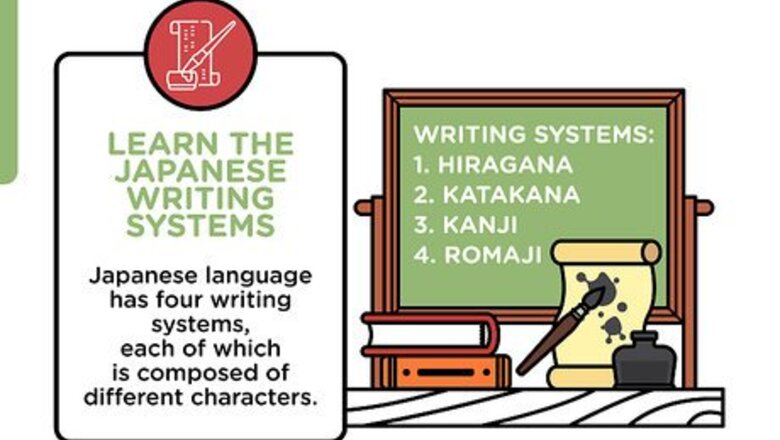
views
The Basics

Learn the Japanese writing systems. Japanese language has 3 writing systems, each of which is composed of different characters. This may sound like a lot to learn, but every word in Japanese, regardless of which writing system it comes from, is pronounced with some combination of only 46 basic sounds. Sorting out the different writing systems and their uses is an important part of learning Japanese. Here's a brief overview: Hiragana is a Japanese syllabary, phonetic characters that make up one Japanese writing system. Unlike the English alphabet, each character stands for one syllable, which may include a vowel and a consonant sound. Katakana is also a syllabary, most often used for foreign words or onomatopoeic sounds (like bang or squeak). Together, hiragana and katakana account for the entire range of sounds in the Japanese language. Kanji are Chinese characters that were adopted as a Japanese writing system. Whereas hiragana and katakana are simply phonetic letters, kanji are ideograms, characters which have meaning. There are thousands of kanji characters, with about 2000 in common use. Hiragana and katakana were derived from these characters. The same 46 sounds that are used to pronounce hiragana and katakana are also used to pronounce kanji. The Latin alphabet is used in Japanese to write acronyms, company names, and other words for aesthetic reasons. Called Romaji ("Roman letters"), Japanese can also be written in Latin letters. This is not done in Japan, but it is used by beginning Japanese speakers to "spell out" Japanese characters. However, there are many sounds in Japanese which are difficult to express in Latin letters, and many homonyms (many more than English) which become confusing. Therefore, students of Japanese are encouraged to begin learning Japanese characters as soon as possible, and avoid using Latin letters as a crutch.
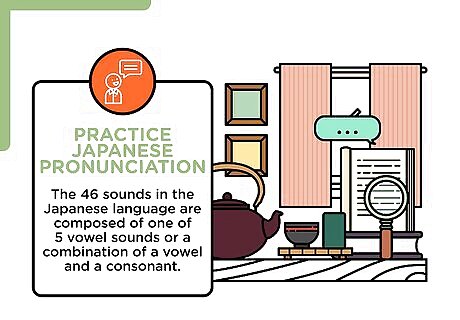
Practice Japanese pronunciation. The 46 sounds in the Japanese language are composed of one of five vowel sounds or a combination of a vowel and a consonant, with the exception of one sound composed of only a consonant. Vowel sounds are not inflected (unlike in English, where "a" in apple vs ace are different). You can start practicing pronunciation by learning how to pronounce each character in hiragana and katakana. See this site for examples of how to pronounce the sounds. Focus on the intonation of the different sounds. Variations on the sounds change the meaning of the words you speak. A long syllable may have a completely different meaning from the same sound made shorter ("o" vs. "oo").
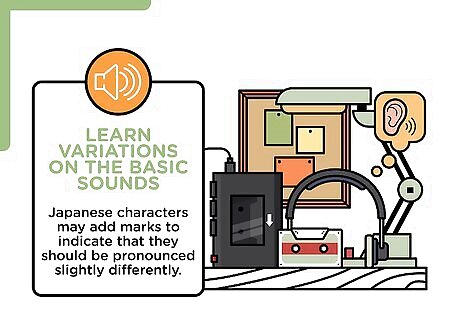
Learn variations on the basic sounds. Japanese characters may add marks to indicate that they should be pronounced slightly differently, sometimes changing the meaning of the words they make up. This similar to "s" sometimes sounding like "z" in English. Hard consonant sounds are pronounced with a hard stop in between two sounds. Long vowel sounds, pronounced by holding the vowel sound for an extra beat, are distinguished from short sounds, indicating a different word.
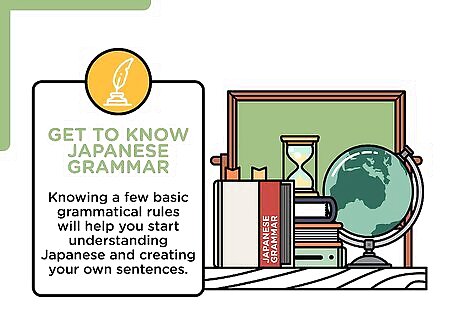
Get to know Japanese grammar. Knowing a few basic grammatical rules will help you start understanding Japanese and creating your own sentences. Japanese grammar is simple and flexible, so it's easy to string words together in a way that makes sense. The subject is optional and is rarely included. The predicate is always at the end of the sentence. Nouns do not have gender. Most also don't have separate plural forms. Verbs do not change according to the subject (he/she/it). They also don't change according to number (singular/plural, like I/we or he/they). Particles, which mark words as subject, object, etc., always follow the word to which they relate. Personal pronouns (I, you, etc.) differ according to the level of politeness and formality that is needed in each situation.
Guided Instruction
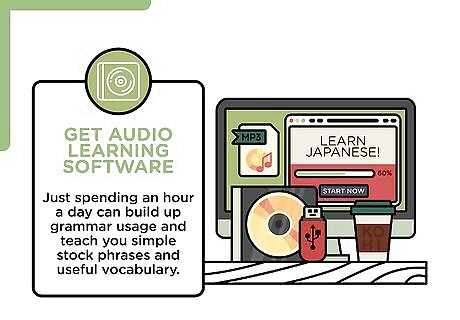
Get audio learning software. After learning the basics, it's time to get some outside instruction so you can improve your skills. If you are learning Japanese for fun because you like Japanese culture such as manga and anime or for travel, an audio learning CD might be all you need. Just spending an hour a day can build up grammar usage and teach you simple stock phrases and useful vocabulary. Listen to the software during your commute to work or have it ready on your portable music player for lunch and breaks or walks in the park. It isn't necessary to learn the reading and writing to enjoy the language and culture, so if you plan on taking a short trip to Japan, knowing a few useful phrases will be more practical than cramming obscure characters into your brain.
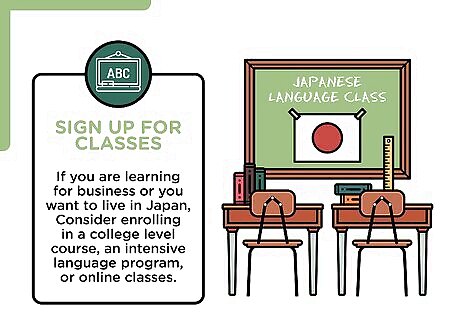
Sign up for classes. If you are learning for business or you want to live in Japan, consider enrolling in a college level course, an intensive language program, or online classes. Learning to read and write will be crucial to your long term success, and having a mentor during the early stages is ideal for developing good study habits and asking all the questions you will have about Japanese language and culture. Study the writing systems. Begin studying all four writing styles early on if literacy is important for your purpose of learning the language. Hiragana and katakana can be learned in a few weeks, and you can use them to write anything you want in Japanese. Around 2,000 kanji are currently in common use in Japanese, so it typically takes several years to learn, but it's worth it if you want to actually be able to understand and speak Japanese. Use flashcards to learn vocabulary and simple phrases. They can be used while waiting for a meeting, on a train, and so on. Some free cards can be found on the web to get you started, or you can buy higher quality cards at most college bookstores or online. To practice kanji, look for cards that show stroke order (how to write the character) represented in calligraphy on one side and have example compound words on the other side. You can pick up a pack of blank 3x5 cards to make your own flash cards with exactly what you want to learn. Participate in class discussions and activities. Do all of your homework, raise your hand a lot, and be as involved as you can to make the most of language classes. If you don't, your skills will not improve.
Immersing Yourself
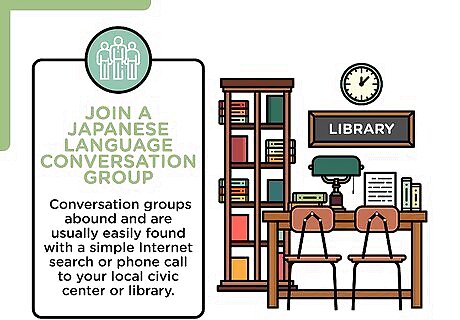
Join a Japanese language conversation group. Conversation groups abound and are usually easily found with a simple Internet search or phone call to your local civic center or library. Train your ears to pick out what is being said. Even if you don't understand it, try to repeat what was said so you can begin to pick it apart and develop comprehension.
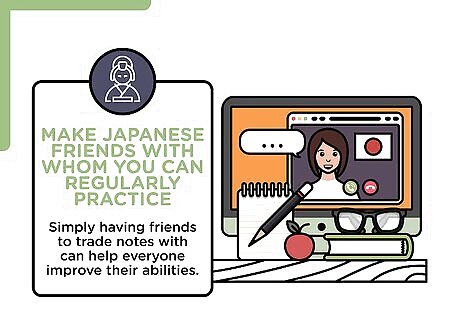
Make Japanese friends who you can practice with. Lots of Japanese people want to learn English, so you may be able to find some who are willing to help you in exchange for help in English. Simply having friends to trade notes with can help everyone improve their abilities. Do things with your friends that involve language but aren't "study time." If your Japanese friends haven't lived in your country very long, show them around town. Go sightseeing. Remember, you have to blow off steam regularly or you'll get stressed out about all those Kanji you have to memorize. Having fun is the best way to accomplish two goals at the same time. On the days when you don't have outings, call up a friend every day and have a half-hour conversation during which you speak only Japanese. The more practice you get, the faster you will improve.

Consume Japanese media. Whether it's the newspaper, a novel, a movie, or a show, read or watch Japanese language media every day. There is lots of TV content on the internet, from comedy to game shows to drama. Find something which fits your interests and learning will be much easier. Japanese newspapers will expose you to the most practical vocabulary and grammar. As you improve, read novels, which will give you a warmer style of writing. Mix things up by watching classic Japanese films and anime without subtitles, or with Japanese character subtitles. Comic books (Manga) can make good reading material, but be aware that the level of sophistication varies greatly. A more mature, literary comic might be good practice (especially since the illustrations help you understand what you are reading), something intended for smaller children is likely to be full of sound effects and slang. Be careful about repeating what you've read in a comic book.
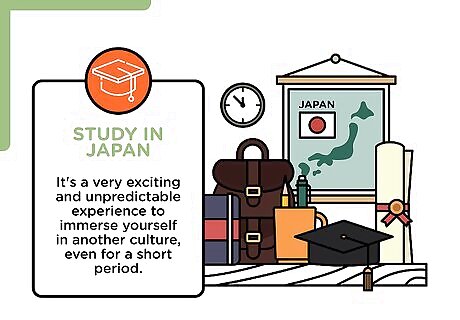
Study in Japan. This is simply the best way to practically apply what you have learned and learn more. It's a very exciting and unpredictable experience to immerse yourself in another culture, even for a short period. Even if you have researched exhaustively, actually experiencing a place will expose you to things you could never have imagined. If you're enrolled in a college or university, ask about programs to study in Japan. This is one of the best ways to gain long-term exposure to Japanese language, and you may be eligible for financial aid. Don't be discouraged if you do not understand everything that is said to you or you can't read or write as well as you expected. It takes many years to become fluent in another language. The intricacies and nuances of the Japanese language make it difficult to master, but they are also part of its beauty.
















Comments
0 comment